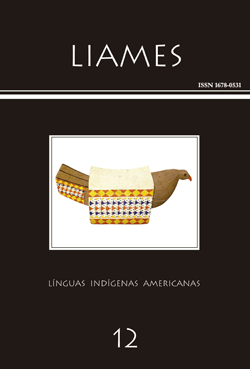Resumo
The paper reports on the speaker-oriented demonstrative clitics =ka ‘near speaker’, =ra ‘not in the speaker’s interactional space’, and =nta ‘far from the speaker’. It is shown that in situational (deictic) use, the most relevant criteria for the three-way choice are the referent’s spatial contiguity to the speaker, touching or direct contact with the referent, pointing with a hand or chin, and eye gaze. Apart from serving as markers of nominal definiteness, the bound forms are found to be used anaphorically, as well as to introduce new participants and mark ‘discourse-new-but-hearer-old’ information. The bound forms are also used on the syntactic levels of predication and subordination. On the predication level, =ka, =ra, =nta function either as adverbial locality clitics or modal operators, whereas in clause combining the bound forms occur as subordinating temporal or locative conjunctions.
Referências
AIKHENVALD, Alexandra (2010). Imperatives and Commands. Oxford: Oxford University Press.
AIKHENVALD, Alexandra; DIXON, R. M. W. (1998). Dependencies between grammatical systems. Language 74 (1): 56-80.
ANDERSON, Stephen (1992). A-Morphous Morphology. Cambridge: Cambridge University Press.
ANDERSON, Stephen; KEENAN, Edward (1985). Deixis. In Timothy Shopen (ed.). Language Typology and Syntactic Description, Vol. 3, pp. 259-308. Cambridge: Cambridge University Press.
BOHNEMEYER, Jürgen (2001). Deixis. In Neil J. Smelser, Paul B. Baltes (eds.). International Encyclopedia of the Social and Behavioral Sciences, Vol. 5, pp. 3371-3375. Oxford:Elsevier.
CHAFE, Wallace (1987). Cognitive constraints on information flow. In Russell Tomlin (ed.). Coherence and Grounding in Discourse, pp. 21-52. Amsterdam: John Benjamins.
CRISTOFARO, Sonia (2003). Subordination. Oxford: Oxford University Press.
DENNY, J. Peter (1982). Semantics of the Inuktikut (Eskimo) spatial deictics. International Journal of American Linguistics 48 (4): 359-384.
DIK, Simon C. (1997). The Theory of Functional Grammar: Part 1: The Structure of the Clause. 2 nd revised edition, ed. Kees Hengeveld. Berlin/New York: Mouton de Gruyter.
DIESSEL, Holger (1999). Demonstratives: Form, Function and Grammaticalization. Amsterdam: John Benjamins.
DIXON, R. M. W. (2003). Demonstratives: A cross-linguistic typology. Studies in Language 27 (1): 61-112.
DRYER, Mathew (2011). Definite articles. Chapter 37. In Matthew Dryer, Martin Haspelmath (eds.). The
World Atlas of Language Structures Online. Available at: http://wals.info/chapter/37/. Accessed: 06/02/2012.
ENFIELD, Nicholas (2003). Demonstratives in space and interaction: Data from Lao speakers and implications for semantic analysis. Language 79 (1): 82-117.
ENFIELD, Nicholas (2005). Comments on William Hanks’ “Explorations in the deictic field”. Current Anthropology 46 (2): 212.
FILLMORE, Charles (1982). Towards a descriptive framework for spatial deixis. In Robert J. Jarvella, Wolfgang Klein (eds.). Speech, Place, and Action: Studies in Deictics and Related Topics, pp. 31-39. London: Wiley.
HANKS, William (1992). The indexical ground of deictic reference. In Alessandro Duranti, Charles Goodwin (eds.). Rethinking Context: Language as an Interactive Phenomenon, pp. 43-77. Cambridge: Cambridge University Press.
HANKS, William (2005). Explorations in the deictic field. Current Anthropology 46 (3): 191-212.
HIMMELMANN, Nikolaus (1996). Demonstratives in narrative discourse: a taxonomy of universal uses. In Barbara Fox (ed.). Studies in Anaphora, pp. 205-254. Amsterdam: John Benjamins.
JACOBSON, Steven (1977). A Grammatical Sketch of Siberian Yupik Eskimo. Fairbanks: Alaska Native Language Center.
LEVINSON, Stephen (1996). Language and space. Annual Review of Anthropology 25: 353-382.
LEVINSON, Stephen (2003). Space in Language and Cognition. Cambridge: Cambridge University Press.
LEVINSON, Stephen (2004). Deixis. In Laurence Horn, Gregory Ward (eds.). The Handbook of Pragmatics, pp. 97-121. Malden, MA: Blackwell.
LYONS, John (1977). Semantics, Vol. 2. Cambridge: Cambridge University Press.
MIHAS, Elena (2010). Essentials of Ashéninka Perené Grammar. Milwaukee: University of Wisconsin dissertation.
MITHUN, Marianne (1987). The grammatical nature and discourse power of demonstratives. Berkeley Linguistics Society Proceedings 13: 184-194.
NUYTS, Jan (2006). Introduction. In William Frawley (ed.). The Expression of Modality, pp. 1-25. Berlin/New York: Mouton de Gruyter.
REED, Judy; PAYNE, David (1986). Ashéninca (Campa) pronominals. In Ursula Wiesemann (ed.). Pronominal Systems, pp. 323-31.Tübingen: Gunter Narr.
ROBERT, Stéphane (2006). Deictic space in Wolof: Discourse, syntax and the importance of absence. In Maya Hickmann, Stéphane Robert (eds.). Space in Languages: Linguistic Systems and Cognitive Categories, pp. 155-174. Amsterdam: John Benjamins.
SENFT, Günter (2004). Introduction. In Günter Senft (ed.). Deixis and Demonstratives in Oceanic Languages, pp. 1-13. Canberra: The Australian National University.
SCHACHTER, Paul; SHOPEN, Timothy (2007). Parts-of-speech systems. In Timothy Shopen (ed.). Language Typology and Syntactic Description. Vol. 1: Clause Structure, 2nd edition, pp.1-60. Cambridge: Cambridge University Press.
TALMY, Leonard (1983). How language structures space. In Herbert Pick, Linda Acredolo (eds.). Spatial Orientation: Theory, Research, and Application, pp. 225-282. New York: Plenum Press.
VAN VALIN, Robert (2001). An Introduction to Syntax. Cambridge: Cambridge University Press.
VAN VALIN, Robert; LaPOLLA, Randy (1997). Syntax: Structure, Meaning and Function. Cambridge: Cambridge University Press.
WALD, Benji (1983). Referents and topic within and across discourse units: Observations from current vernacular English. In Flora Klein-Andreu (ed.). Discourse-Perspectives on Syntax, pp. 91-116. New York: Academic Press.
A LIAMES: Línguas Indígenas Americanas utiliza a licença do Creative Commons (CC), preservando assim, a integridade dos artigos em ambiente de acesso aberto.
Os artigos e demais trabalhos publicados na LIAMES: Línguas Indígenas Americanas, publicação de acesso aberto, passa a seguir os princípios da licença do Creative Commons. Uma nova publicação do mesmo texto, de iniciativa de seu autor ou de terceiros, fica sujeita à expressa menção da precedência de sua publicação neste periódico, citando-se a edição e a data desta publicação.

